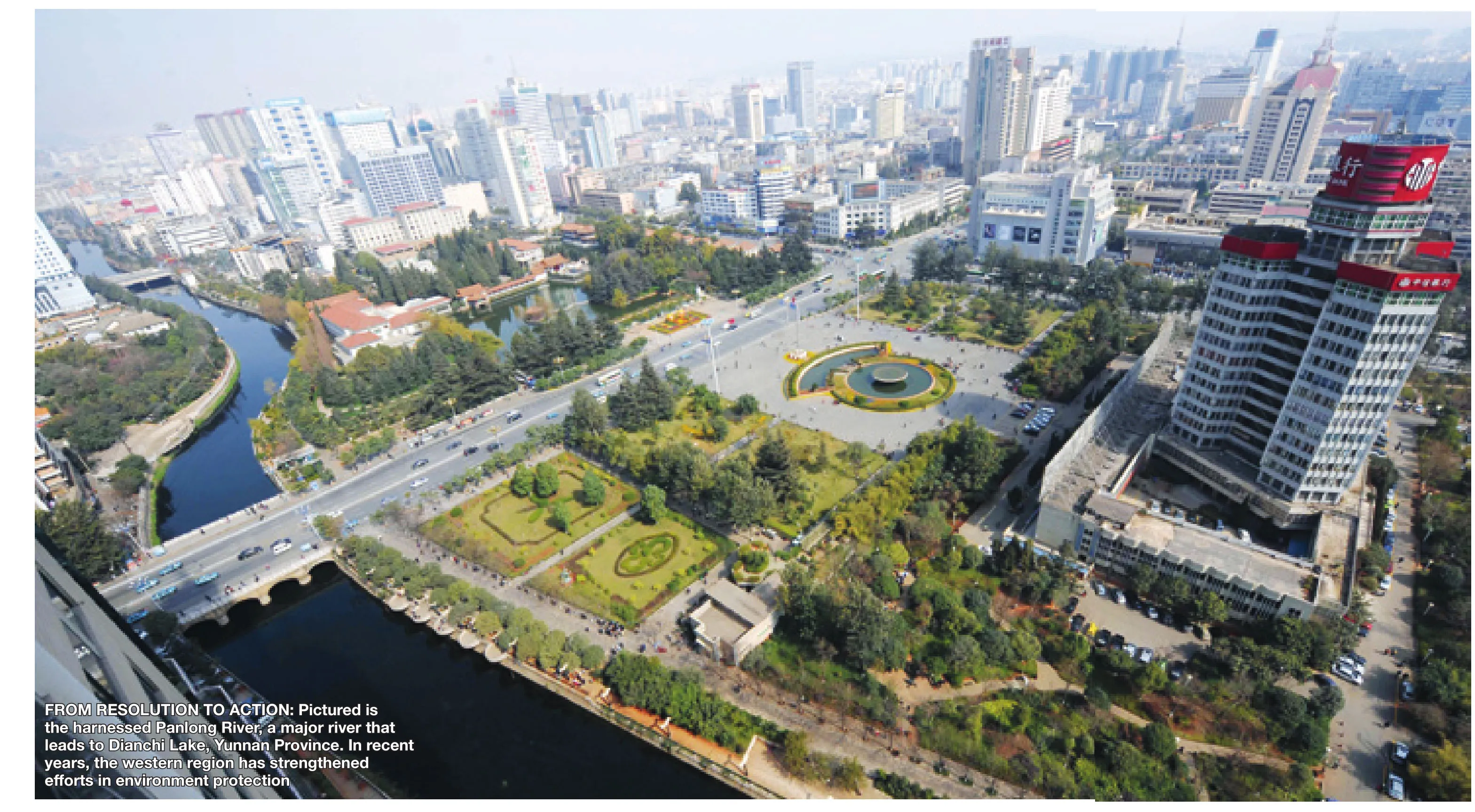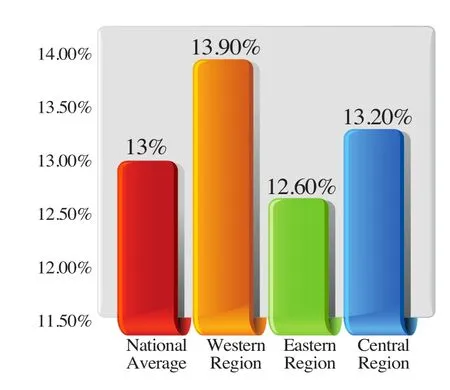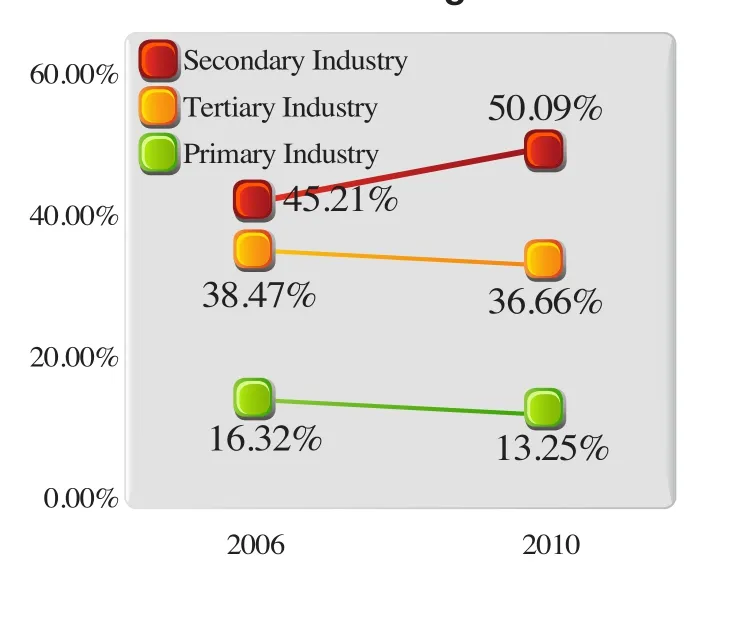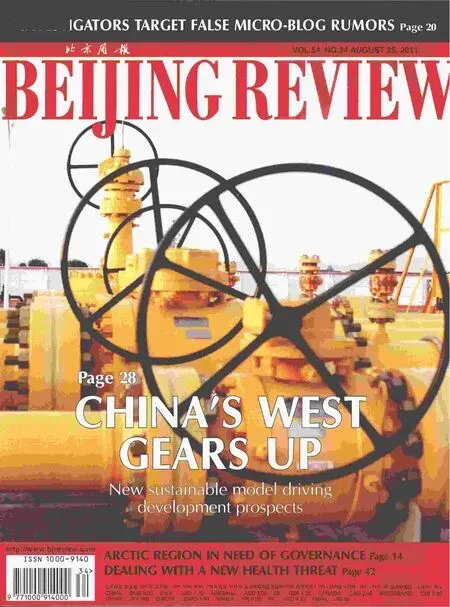THE WESTERN REGION RISING
By LAN XINZHEN
THE WESTERN REGION RISING
By LAN XINZHEN

QIN QING
China’s west is pursuing economic growth using its advantages in human and natural resources, while the east transforms its economic structure
The center of China’s economic growth is gradually shifting west. In the next few decades, China’s western region will be more attractive to investors than the eastern region, and the west will offer more investment opportunities, said Chen Wei, a researcher with China Minzu Securities Co. Ltd.
In the first half of this year, economic growth in the western region was best described as a “locomotive” that drove the rest of the country’s economic growth. Figures from the National Bureau of Statistics show China’s east coastal region’s GDP growth rates became sluggish, all lower than 10 percent, while the country’s west has maintained double-digit growth at an average of 13 percent. Inner Mongolia, the star of the western region, achieved economic growth of 16.5 percent, much higher than the national average of 9.6 percent.
“The economic status of the western region is expected to increase,” said Yao Huiqin, Executive Deputy Director of the Research Center of West China’s Economic Development at the Northwest University in Xi’an, Shaanxi Province. Yao’s team, in cooperation with the Chinese Academy of Social Sciences (CASS), released the Annual Report on Economic Development in the Western Region of China (2011) on July 24. The report says, the west’s economic growth rate will continue to drive national economic growth.
As the western region records astonishing economic progress, questions are being asked if the eastern coastal region has depleted its competitive advantages and if the future of China’s economic growth will rely solely on the western region.
New growth point
To develop the economy in line with the reform and opening-up policy launched in the late 1970s, the Central Government proposed to develop the east coastal region frst. In 1984, the government designated 14 cities in the east, including Dalian, Tianjin, Shanghai, Wenzhou and Guangzhou, as open coastal cities, offering favorable policies different from inland cities in order to attract foreign investment.
This policy has proven to be the right choice as made apparent by the economic growth in the following 30 years. Three economic belts around the Bohai Sea, the Yangtze River Delta and the Pearl River Delta have been formed as the core to promote the nation’s sustained and rapid economic growth. In 2008, the GDP in the eastern region accounted for 54.3 percent of the national total, up 10.9 percentage points since 1978.
During the development phase in the past three decades, many eastern cities have developed rapidly, such as Tianjin, Shanghai, Guangzhou and Shenzhen, bringing about great social changes.
With the east’s rapid development, the central and western regions fell behind and the regional economic disparity has grown. Large numbers of migrant workers swarmed into east coastal areas looking for jobs in the newly prosperous region. The wide gap between the rich and the poor has also led to disparities in education, health care, housing and other aspects, causing more social conficts.
Since the 1990s, the Chinese Government took steps to assuage these problems, mainly by implementing the western development strategy, by revitalizing the traditional industrial bases in northeast China and by promoting investment in the central region. These policies have boosted the development of central and western regions, raising their major economic indicators to approach to those of the eastern region.
CASS fgures show, from 2006 to 2010 the economic growth rate in the western region was higher than the national average. In the past fve years, the average growth of the GDP in the western region was 13.9 percent, which was 0.9 percentage points higher than the national average.
“The western region has witnessed steady and fast economic growth with less fluctuations and smaller potential risks in economic operations,” said the annual economic development report.
Just as the western region develops rapidly, the eastern area has been mired in turmoil following the global fnancial crisis in 2008.
Since the eastern region has adopted an economic growth pattern reliant on exporting primarily processed products, the technological level of the products is low and most of the industries are laborintensive. Low product price is the major weapon for making profits. Once the manufacturing costs, such as labor and raw materials, increase, the economy in the eastern region will take a hit.
After the global financial crisis broke out, China’s exports decreased drastically. To cope with the crisis, the United States adopted a quantitative easing policy and China launched a 4-trillion-yuan ($586-billion) stimulus package. These practices have led to a serious excess of money in international and domestic markets. The accelerated infation has not only driven price hikes of raw materials, but also increased labor costs. In addition, the eastern region has suffered shortages of labor, electricity and land in recent years.
For these reasons, GDP in the eastern region slowed and even declined in 2009. From the first half of 2009, GDP growth rates in the western region began to surpass those of the eastern region.
Enterprises head westward
At the end of this year, the apparel production base in Anhui Province invested by Tedelon Holding Group Co. Ltd. will start operation. According to plans made by Wang Peihuo, President of Tedelon, in the future all the group’s production will be transferred to central and western regions.
Tedelon is a large apparel enterprise headquartered in east China’s Zhejiang Province. Wang said the reason for the company to go westward is that increasing costs have restricted the development of enterprises in coastal areas.
Guangdong Province is home to a large number of small and medium-sized textile enterprises. After analyzing cost disparities between southeast coastal areas and central and western regions, Liu Yueping, Chairman of the Guangdong Clothing Industry Association, found that costs of apparel enterprises in Guangdong are 30 percent higher than those in central and western regions.
Liu said, affected by labor shortage and increasing costs, textile companies in east coastal areas have been transferring to provinces in central and western regions, such as Jiangxi and Sichuan.
On June 28 this year, China National Textile and Apparel Council (CNTAC) and 16 textile companies jointly released a social responsibility report. Sun Ruizhe, Vice Chairman of CNTAC, said the industrial transfer is self-motivated, since the western region can offer better labor resources, thus reducing labor costs.
Sun said the east-to-west transfer of the Chinese textile industry is not simply a transfer of production capacity, but projects an overall advancement of the industry’s tech-nologies, human resources, environment and social responsibilities.
Besides textile and apparel enterprises, labor-intensive companies such as toy manufacturers and shoemakers are also seeking to go westward. Xiong Xiaokun, a light industry researcher with the CIConsulting Industrial Research Center, said these transfers represent a general trend and will effectively promote the economic development in central and western regions.
The industrial transfer was not “omnipotent,” Xiong said. Related supporting facilities in central and western regions are not yet sound, which will affect corporate development to some extent.
Besides labor costs, companies also need to take issues, such as market atmosphere, into account. They should also consider the approach of local governments, but most importantly, whether the industrial chains are complete. If the industrial chains are not complete, companies will also face cost pressures.
Xiong said there are three major differences between the eastern region and the central and western regions: completeness of related supporting facilities, market concentration and coverage of marketing channels.
The industrial transfer, which has just started, has received the support of the Chinese Government. In September 2010 the State Council, the country’s cabinet, issued Guiding Opinions on the Central and Western Regions’ Undertaking of Industrial Transfer, which says that to further improve the investment environment in the central and western regions and guide and support orderly industrial transfer, local governments can grant necessary policy support in aspects of taxation, fnance, investment and land use.
East seeks breakthroughs
The eastern region will never accept a slower economic growth rate than its western regional counterpart. It hopes to seek breakthroughs by strengthening integration of resources and innovation of systems to realize new economic growth.
Local officials are fully aware of the diffculties the east faces in its economic development. The Central Government sees this too. To change the situation, the eastern region has been considering an industrial transformation since 2006. In spite of numerous investigations and seminars on this topic, local officials still cannot make up their minds. Since industrial transfer will affect the local economy, no offcial is willing to suffer these kinds of setbacks during his or her tenure.
The global fnancial crisis forced central and local governments to switch gears, replacing the 30-year-old strategy that “the east coastal area develops frst” with “the eastern region develops better.”
In 2009, the Pearl River Delta, where Guangzhou and Shenzhen are located, stepped out the first step of transformation. On January 8, 2009, the National Development and Reform Commission (NDRC) issued the Outline of Pearl River Delta Regional Plan on Reformation and Development (2008-20). New development ideas are offered to this region with a large number of labor-intensive manufacturing enterprises: to become a pilot region for deepening the reform, an important international gateway to expand the reform, a world base of advanced manufacturing industries and modern service industries and an important economic center in China.
The Central Government also repositioned the role of Shanghai. In April 2009 the State Council issued Opinions on Promoting the Development of Shanghai’s Modern Service Industry and Advanced Manufacturing Industry and Promoting the Construction of the Shanghai International Financial Center and International Shipping Center. This is a document guiding the transformation of Shanghai, whose economic development pattern will be transferred from investment driven to innovation driven.
After that, a series of plans guiding economic transformation of the eastern region, such as the economic zone on the west bank of the Taiwan Straits, regional planning of the Yangtze River Delta and development planning of coastal areas of Jiangsu Province, have been promulgated.
Two years have passed, and the eastern region has been accelerating its steps of industrial restructuring and transforming the economic growth pattern. In Zhejiang Province, where the textile and apparel industry is mature, traditional industries are being transformed and upgraded as new pillar industries such as photovoltaic and other new energy industries are developed.
In the first half of 2011, the number of invention patent applications and approvals in Zhejiang Province increased by 41.6 percent and 65.4 percent, respectively, contributions of the tertiary industry to the GDP reached 83.5 percent, and the proportion of added value realized by the tertiary industry in the GDP increased by 3.2 percentage points.
“Shoe-making and apparel industries in Zhejiang and other developed coastal areas have begun to transfer to inland areas such as Jiangxi and Sichuan provinces since last year. This also indicates that the slower economic growth in the eastern region is also contributing to a more coordinated development among different regions,” said the Development and Reform Commission of Zhejiang Province.
Zhang Zhuoyuan, a researcher at the Institute of Economics of CASS, said transformation of the economic growth pattern is a fundamental issue deciding sustainable and sound economic development in China. The global financial crisis makes it urgent for China to transform its economic growth pattern.

GDP Growth (2006-10)

GDP Proportion of Western Region In National Total

Industrial Proportion in the GDP Of Western Region
Zhang said, when transforming the economic growth pattern, the priority is to change the GDP-oriented mechanism of as-sessing the performance of local offcials and making them focus on promoting industrial restructuring and improving the independent innovation capability.

He said the transformation is unlikely to be completed within three or fve years, and it may need as long as eight to 10 years.
Yao said different from the eastern region, the western region is mainly restricted by the rural-urban development divide.
“The overall standard of living of rural and urban residents is still low and the absolute disparity with that of the eastern region continues to expand,” Yao said.
Figures from the Annual Report on Economic Development in the Western Region of China (2011) show that although the growth rate of rural and urban residents’incomes in the western region is higher than the national average, the absolute amount of resident income is still the lowest among all the regions.
“Eliminating poverty and accelerating development are still the biggest challenges the western region faces,” Yao said.
Coordinated development
Although its economic growth has slowed and corporate costs are increasing, the east coastal area is still the most attractive region in China. According to figures released by the Ministry of Commerce, in the frst half of this year, China received $60.89 billion in paid-in capital, up 18.4 percent year on year. Although the growth rate of paid-in capital in western and central regions continues to exceed that in the eastern region, the absolute amount is still lower than that in the eastern region.
Wang Yiming, ExecutiveDeputy Director of the Academy of Macroeconomic Research of the NDRC, said the Chinese Government hopes to realize coordinated regional development, instead of encouraging arguments such as which region is more attractive, eastern, central or western.

(Source: Annual Report on Economic Development in the Western Region of China (2011))
Wang said since 2000, China has implemented regional development strategies to boost western development, revitalize traditional industrial bases in northeast China and promote the rise of the central region. The efforts have helped strengthen favorable investment in the three regions, improve local infrastructure and investment environment and enhance local public services. In the meantime, the eastern region, relying on its economic advantages, has improved its overall competitiveness. The three regions have selected different development patterns.
At present, respective comparative advantages of eastern and western regions are being utilized and the regional division of labor turns to be more specifc. Fast-growing basic industries and processing industries such as iron and steel, building materials, non-ferrous metals, automobiles and electronics are concentrating to the east coastal area, while energy and other industries highly depending on resources are concentrating in the western region. For example, southwest China has established large-scale hydropower development industry, while northwest China is exploiting oil and gas resources.
Wang said the nuclear target of China’s policy of regional development is to solve regional disparities and coordinate regional interests. Although the real performance is far behind the goal, the government is trying to establish frameworks of regional economic policies under a market economy.
Zhang Shuguang, a researcher at the Institute of Economics of CASS, hopes decision-makers in the western region remain focused when facing rapid economic growth.“The western region should not go forward too fast, but should learn from the eastern area’s experiences and avoid their failures,”Zhang said.

